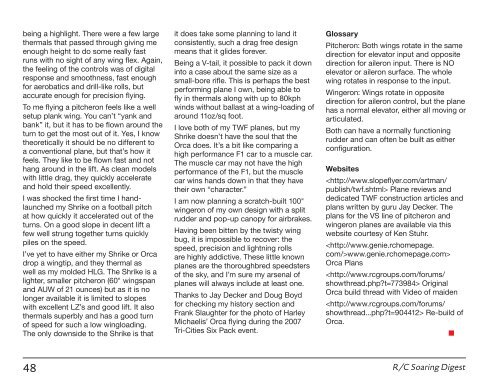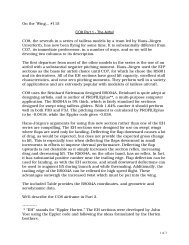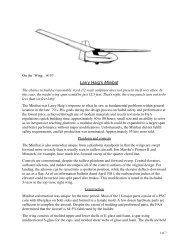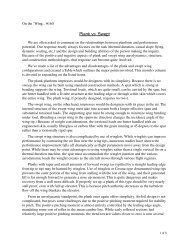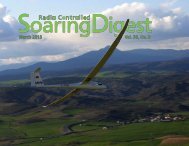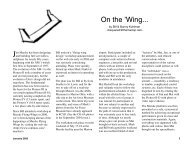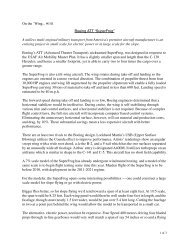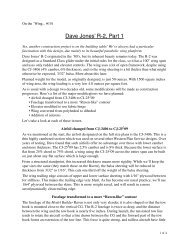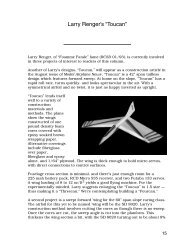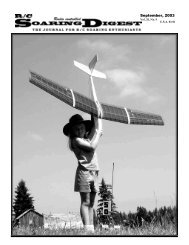Oct - Rcsoaring.com
Oct - Rcsoaring.com
Oct - Rcsoaring.com
- No tags were found...
You also want an ePaper? Increase the reach of your titles
YUMPU automatically turns print PDFs into web optimized ePapers that Google loves.
eing a highlight. There were a few largethermals that passed through giving meenough height to do some really fastruns with no sight of any wing flex. Again,the feeling of the controls was of digitalresponse and smoothness, fast enoughfor aerobatics and drill-like rolls, butaccurate enough for precision flying.To me flying a pitcheron feels like a wellsetup plank wing. You can’t “yank andbank” it, but it has to be flown around theturn to get the most out of it. Yes, I knowtheoretically it should be no different toa conventional plane, but that’s how itfeels. They like to be flown fast and nothang around in the lift. As clean modelswith little drag, they quickly accelerateand hold their speed excellently.I was shocked the first time I handlaunchedmy Shrike on a football pitchat how quickly it accelerated out of theturns. On a good slope in decent lift afew well strung together turns quicklypiles on the speed.I’ve yet to have either my Shrike or Orcadrop a wingtip, and they thermal aswell as my molded HLG. The Shrike is alighter, smaller pitcheron (60" wingspanand AUW of 21 ounces) but as it is nolonger available it is limited to slopeswith excellent LZ’s and good lift. It alsothermals superbly and has a good turnof speed for such a low wingloading.The only downside to the Shrike is thatit does take some planning to land itconsistently, such a drag free designmeans that it glides forever.Being a V-tail, it possible to pack it downinto a case about the same size as asmall-bore rifle. This is perhaps the bestperforming plane I own, being able tofly in thermals along with up to 80kphwinds without ballast at a wing-loading ofaround 11oz/sq foot.I love both of my TWF planes, but myShrike doesn’t have the soul that theOrca does. It’s a bit like <strong>com</strong>paring ahigh performance F1 car to a muscle car.The muscle car may not have the highperformance of the F1, but the musclecar wins hands down in that they havetheir own “character.”I am now planning a scratch-built 100"wingeron of my own design with a splitrudder and pop-up canopy for airbrakes.Having been bitten by the twisty wingbug, it is impossible to recover: thespeed, precision and lightning rollsare highly addictive. These little knownplanes are the thoroughbred speedstersof the sky, and I’m sure my arsenal ofplanes will always include at least one.Thanks to Jay Decker and Doug Boydfor checking my history section andFrank Slaughter for the photo of HarleyMichaelis’ Orca flying during the 2007Tri-Cities Six Pack event.GlossaryPitcheron: Both wings rotate in the samedirection for elevator input and oppositedirection for aileron input. There is NOelevator or aileron surface. The wholewing rotates in response to the input.Wingeron: Wings rotate in oppositedirection for aileron control, but the planehas a normal elevator, either all moving orarticulated.Both can have a normally functioningrudder and can often be built as eitherconfiguration.Websites Plane reviews anddedicated TWF construction articles andplans written by guru Jay Decker. Theplans for the VS line of pitcheron andwingeron planes are available via thiswebsite courtesy of Ken Stuhr.www.genie.rchomepage.<strong>com</strong>>Orca Plans OriginalOrca build thread with Video of maiden Re-build ofOrca.n48 R/C Soaring Digest


